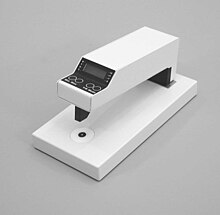Densitometer
Densitometers are devices for the quantitative measurement of the color density ( full tone density ) and optical density of printed products and, in particular, in photo technology for measuring the blackening in negatives , slides and paper images. Densitometers are also used as so-called TLC scanners for the quantitative evaluation of thin-layer chromatograms . The measurements can be used in the visible , in the ultraviolet spectral range as well as for fluorescence measurements. In contrast to a spectrophotometer , a densitometer can only measure tone values , not color tones . In a densitometer, the tone value is defined using the Murray-Davies formula . Densitometers are also used in geotechnics to determine the density of a soil.
Differentiation areas
One distinguishes
- See-through densitometer for measuring transparencies such as film materials (the transmission is measured here) and
- Supervisory densitometer for measuring the reflectance of reflective originals such as with paper images (here, the measured remission).
Some grades are able to take see-through and top- view measurements by flipping a built-in switch. These are particularly suitable for creating analog photographs. Photo lab technicians use this to select a suitable photo paper from a previously measured negative without having to bother with test strips.



